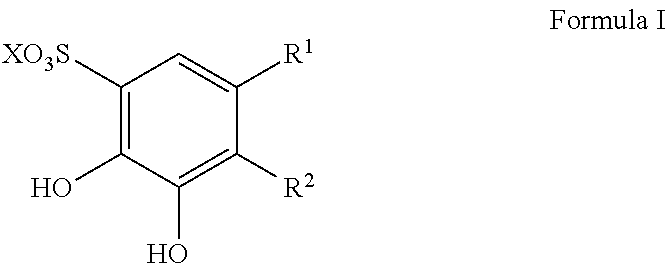Sulfonation of polyhydroxyaromatics
a technology of hydroxyaromatics and sulfonates, which is applied in the field of sulfonation of polyhydroxyaromatics, can solve the problems of substantial salt waste stream, no commercially practical or cost effective solution, and current too expensive to make for commercial purposes
- Summary
- Abstract
- Description
- Claims
- Application Information
AI Technical Summary
Benefits of technology
Problems solved by technology
Method used
Image
Examples
example a
Procedure from WO 2007 / 144344 A1 by Rhodia
[0043]Into a 1 L flask containing 682 g of sulfuric acid was added 150 g of catechol at RT. The reaction mixture was heated to 85-90° C. for 5 h for the sulfonation process to occur. When the reaction mixture has cooled down to 50° C., 231.9 g of 47% NaOH solution was added to the reaction mixture and 1,2-dihydroxy-3,5-benzenedisulfonate sodium salt precipitated. The reaction mixture was cooled down to 15-25° C. and the solid was filtered through a Büchner funnel. The solid was washed (3×) with 115 g of isopropanol and dried under vacuum at 60° C. to provide 290 g of Tiron™ as an off-white solid in a yield of 68%. Thus this process requires neutralization with base and forms the salt.
example b
Sulfonation of pyrogallol (PG) with H2SO4 at 90° C. for 5 h
[0044]
[0045]Into a RBF containing PG (10 g, 79.3 mmol), sulfuric acid (38.9 g, 396 mmol) was added. The mixture was heated at 90° C. in an oil bath for 5 h. The reaction was allowed to cool to 50° C. and aqueous NaOH (6.36 g in 20 mL water) was added dropwise to the reaction mixture and the resulting precipitate was obtained by filtration.
[0046]The 1H NMR of the isolated solid has only one peak at 7.1 ppm; however, no carbon was detected by 13C NMR, suggesting that the isolated solid might be of some inorganic salt. Thus this process as disclosed by Rhodia in the patent WO 2007 / 144344 A1 is not applicable for production of the desired 4,5,6-trihydroxy-1,3-benzenedisulfonic acid for further use.
[0047]Present invention using catechol derived from biomass as the starting compound.
example 1
Sulfonation of Catechol in Concentrated H2SO4
[0048]
[0049]The sulfonation of catechol derived from biomass using concentrated sulfuric acid was followed as described in Example A with minor modifications.
[0050]Into a 1 L RBF containing 682 g of concentrated (98%) sulfuric acid, was added 150 g of catechol at RT. The mixture was heated at 95° C. for 5 h. When the reaction mixture was cooled to 50° C., 232 g of 47% (by weight) NaOH solution in water was added dropwise via an addition funnel to the reaction mixture to precipitate 1,2-dihydroxy-3,5-benzenedisulfonate sodium salt. Upon complete addition of NaOH solution, the reaction was cooled to 15-25° C. and the precipitate was filtered through a Büichner funnel. The solid was washed with isopropanol (600 mL) and dried under vacuum at 60° C. to yield 312 g (73% yield) of 1,2-dihydroxy-3,5-benzenedisulfonate sodium salt as an off-white solid.
Present invention using pyrogallol (PG) derived from biomass as the starting material.
PUM
| Property | Measurement | Unit |
|---|---|---|
| temperature | aaaaa | aaaaa |
| temperature | aaaaa | aaaaa |
| temperatures | aaaaa | aaaaa |
Abstract
Description
Claims
Application Information
 Login to View More
Login to View More - R&D
- Intellectual Property
- Life Sciences
- Materials
- Tech Scout
- Unparalleled Data Quality
- Higher Quality Content
- 60% Fewer Hallucinations
Browse by: Latest US Patents, China's latest patents, Technical Efficacy Thesaurus, Application Domain, Technology Topic, Popular Technical Reports.
© 2025 PatSnap. All rights reserved.Legal|Privacy policy|Modern Slavery Act Transparency Statement|Sitemap|About US| Contact US: help@patsnap.com



